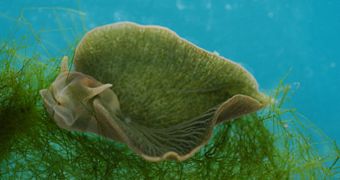Scientists investigating the green sea slug have made some incredible discoveries. It would appear that the creature has “stolen” numerous genes from plants during the course of its evolution, which means that it is now the only creature in the world that can produce chlorophyll. The finding is remarkable, because it shows in essence that the slug is half animal, half plant, a type of hybrid that has not been encountered before. Elysia chlorotica is even shaped like a leaf, Wired reports, which only goes to add to its oddity.
The new investigation was conducted by researchers at the University of South Florida in Tampa, led by expert Sidney K. Pierce. The slug has been known for a long time to be stealing photosynthesizing organelles from algae, as well as a number of genes from the same organisms. However, what researchers didn't know was that, in time, the animal collected sufficient genetic material from plants to allow for the development of a plant chemical-making pathway. Apparently, this type of mechanism can work inside the body of an animal, much to the surprise of biologists.
“This could be a fusion of a plant and an animal – that’s just cool,” invertebrate zoologist John Zardus, from The Citadel, in Charleston, says. According to a report Pierce presented at the meeting of the Society for Integrative and Comparative Biology, on January 7, the green sea slug is able to produce a common form of chlorophyll, which is the green pigment that allows plants to convert sunlight into usable energy. The USF team also found that E. chlorotica did not depend on chlorophyll reserves it stole from algae, rather it could produce its own pigment.
The green sea slug is also amazing because it has a tremendously interesting gut. The research group determined that, when the animal ate the photosynthesizing organelles in algae, called chloroplasts, its gut trapped the cells and kept them in working order for more than a year. This is the average life span of E. chlorotica. This is the first known species of animals to be able to do that. Other slug species also consume chloroplasts, but they are unable to maintain them in working order. But the cherry on top of the cake is that, if enough sunlight is available, the slug never has to eat ever again, after seeping its first chloroplast-laden alga meal. All it needs to do is stay in the sunlight.

 14 DAY TRIAL //
14 DAY TRIAL //